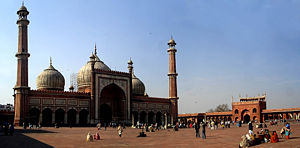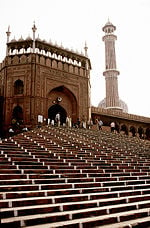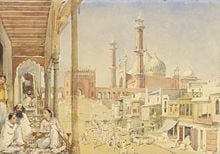Jama Masjid, Delhi
| Jama Masjid | |

| |
| Basic information | |
|---|---|
| Location | |
| Geographic coordinates | |
| Religious affiliation | Islam |
| District | Central Delhi |
| Ecclesiastical status | Mosque |
| Architectural description | |
| Architectural type | Mosque |
| Architectural style | Islamic, |
| Year completed | 1656 |
| Specifications | |
| Capacity | 25,000 |
| Length | 80 m |
| Width | 27 m |
| Dome/s | 3 |
| Minaret/s | 2 |
| Minaret height | 41 m |
The Masjid-i-Jahan Numa (Urdu: مسجد جھان نمہ), commonly known as the Jama Masjid of Delhi, is the principal mosque of Old Delhi in India. Commissioned by the Mughal Emperor Shah Jahan, builder of the Taj Mahal, and completed in the year 1656 C.E., it is one of the largest and best-known mosques in India. It is also at the beginning of a very busy and popular street/center in Old Delhi, Chandni Chowk.
Masjid-i-Jahan Numa means "the mosque commanding a view of the world," and the name Jama Masjid is a reference to the weekly congregation observed on Friday (the yaum al-jum`a) at the mosque. The courtyard of the mosque can hold up to twenty-five thousand worshippers. The mosque also houses several relics in a closet in the north gate, including a copy of the Qur'an written on deer skin.
Construction
The mosque was the result of the efforts of over 5,000 workers, over a period of six years.[1] [2] The cost incurred on the construction in those times was 10 lakh (1 million) Rupees. Shah Jahan built several important mosques in Delhi, Agra, Ajmer and Lahore. Its majesty is further enhanced because of the high ground that he selected for building this mosque. The architecture and design of the Badshahi Masjid of Lahore built by Shah Jahan's son Aurangzeb in 1673 is closely related to the Jama Masjid in Delhi.[3]
Architecture
The courtyard of the mosque can be reached from the east, north and south by three flights of steps, all built of red sandstone. The northern gate of the mosque has 39 steps. The southern side of the mosque has 33 steps. The eastern gate of the mosque was the royal entrance and it has 35 steps. These steps used to house food stalls, shops and street entertainers. In the evening, the eastern side of the mosque used to be converted into a bazaar for poultry and birds in general. Prior to the Indian rebellion of 1857 (which many Indian historians call the The 1857 War of Independence), there was a madrassah near the southern side of the mosque, which was pulled down after the mutiny.[4]
The mosque faces west. Its three sides are covered with open arched colonnades, each having a lofty tower-like gateway in the centre. The mosque is about 261 feet (80 m) long and 90 feet (27 m) wide, and its roof is covered with three domes with alternate stripes of black and white marble, with its topmost parts covered with gold. Two lofty minarets, 130 feet (40 m) high, and containing 130 steps, longitudinally striped with white marble and red sandstone, flank the domes on either side. The minarets are divided by three projecting galleries and are surmounted by open twelve-sided domed pavilions. On the back of the mosque, there are four small minarets crowned like those in the front.[5]

Under the domes of the mosque, is a hall with seven arched entrances facing the west and the walls of the mosque, up to the height of the waist, are covered with marble.[7] Beyond this is a prayer hall, which is about 61 by 27.5 meters (200.131 ft × 90.223 ft) , with eleven arched entrances, of which the centre arch is wide and lofty, and in the form of a massive gateway, with slim minarets in each corner, with the usual octagonal pavilion surmounting it. Over these arched entrances there are tablets of white marble, 4 feet (1.2 m)long and 2.5 feet (0.76 m) wide, inlaid with inscriptions in black marble. These inscriptions give the history of the building of the mosque, and glorify the reign and virtues of Shah Jahan. The slab over the centre arch contains simply the words "The Guide!"
The mosque stands on a platform of about five feet (1.5 m) from the pavement of the terrace, and three flight of steps lead to the interior of the mosque from the east, north, and the south. The floor of the mosque is covered with white and black marble ornamented to imitate the Muslim prayer mat; a thin black marble border is marked for the worshippers, which is three feet long and 1 ½ feet wide. In total there are 899 such spaces marked in the floor of the mosque. The back of the mosque is cased over to the height of the rock on which the mosque stands with large hewn stones.
2006 explosions
On April 14, 2006, two explosions occurred within Jama Masjid. The first explosion came at around 17:26 and the second around seven minutes later at around 17:33 (IST) . At least thirteen people were injured in the blasts. There were around 1000 people in the mosque at the time of blasts as the day happened to be Friday, a Muslim holy day, and because it was the first Friday after Milad un Nabi, Islamic prophet Muhammad's birthday. According to official spokesmen, there was no damage to the mosque itself.
Gallery
See also
- Islamic architecture
- Islamic art
- Sahn
- Timeline of Islamic history
Notes
- ↑ "Heaven on Earth: Islam," November 23, 2004 video documentary, History Channel. Producer/director, Stephen Rooke. Scriptwriter/host: Christy Kenneally
- ↑ Ahsan Jan, Qaisar, Building construction in Mughal India: the evidence from painting (Delhi: Oxford University Press, 1988). p. 13
- ↑ Zulfiqar Ahmad, Mughal India, Selections from Journal of the Panjab Historical Society 3 (Lahore, Pakistan: Sang-E-Meel Publications, 1982), p. 47.
- ↑ Carr Stephen, Archaeology and monumental remains of Delhi (Allahabad: Kitab Mahal, 1967), p. 250
- ↑ Carr, Archaeology and monumental remains of Delhi, p. 251
- ↑ Paul La Porte
- ↑ Carr, Archaeology and monumental remains of Delhi, p. 251
ReferencesISBN links support NWE through referral fees
- Ahmad, Zulfiqar. 1982. Mughal India. Selections from Journal of the Panjab Historical Society, 3. Lahore, Pakistan: Sang-E-Meel Publications. OCLC 10146287.
- Stephen, Carr. 1967. Archaeology and monumental remains of Delhi. Allahabad: Kitab Mahal. OCLC 1879746.
- Qaisar, Ahsan Jan. 1988. Building construction in Mughal India: the evidence from painting. Delhi: Oxford University Press. ISBN 9780195622607.
External links
Links Retrieved December 3, 2008.
- Jama Masjid (Delhi)page at India Image, the Government of India Information portal.
- Jama Masjid, Delhi page at India Profile, a travel information site.
- "Saudi offer to fix Delhi mosque" (BBC) accessed January 5
- Pictures of the Jama Masjid in Delhi
- Jama Masjid
- Satellite picture by Google Maps
| Jama Masjid | |||||||||||||||||||||||||||||||||||||||||
| |||||||||||||||||||||||||||||||||||||||||
Credits
New World Encyclopedia writers and editors rewrote and completed the Wikipedia article in accordance with New World Encyclopedia standards. This article abides by terms of the Creative Commons CC-by-sa 3.0 License (CC-by-sa), which may be used and disseminated with proper attribution. Credit is due under the terms of this license that can reference both the New World Encyclopedia contributors and the selfless volunteer contributors of the Wikimedia Foundation. To cite this article click here for a list of acceptable citing formats.The history of earlier contributions by wikipedians is accessible to researchers here:
The history of this article since it was imported to New World Encyclopedia:
Note: Some restrictions may apply to use of individual images which are separately licensed.










